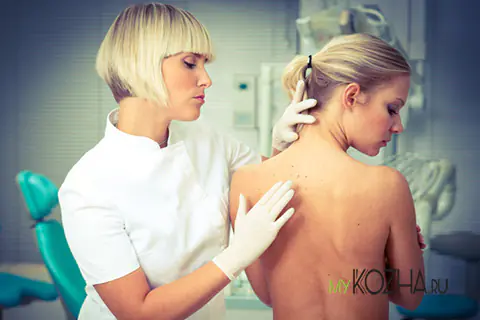Due to changes in hormonal levels, a woman often notices new moles on her body during pregnancy. How dangerous is this condition, and what measures should be taken to treat it?
Moles during pregnancy: causes and treatment methods
The appearance of new formations on the skin causes a strong feeling of anxiety in a pregnant woman.
Some fear their degeneration into malignant ones and immediately run to doctors to have moles removed.
What is associated with the process of the appearance of new moles on the body, and what danger does it pose to the health of the mother and her unborn child?
What is a mole on the body called?
This is a congenital or acquired benign formation on the body. It can have different sizes and shapes, and does not cause any unpleasant sensations to a person. Moles appear on the body from birth and are localized in different parts of the body (back, face, stomach, legs, etc.). The impetus for the appearance of such formations is an excess of ultraviolet rays. Their action provokes the deposition of pigment under the skin, which over time turns into melanocytes (birthmarks).
When they grow
The first dotted spots appear in children in the first year of life. Also, the impetus for the formation of new moles is hormonal changes during puberty or pregnancy. In the latter case, new formations may disappear after the birth of the child and do not pose any danger to the health of the woman and her unborn child.
If new moles grow during pregnancy
With the appearance of new nevi on a woman’s body, doctors assess the functioning of the hormonal system as excellent. During pregnancy, hormone levels undergo dramatic changes, and the body begins to work for two.
The appearance of new moles on the body is considered a normal process that should not cause any concern. The color of the formation depends on the amount of melanocyte accumulated in it.
Small flat
They have the shape of spots, elastic and soft in consistency, the shade depends on the amount of accumulated pigment (in most cases they have a brown tint). The risk of their degeneration into malignant ones is small. The impetus for this process can be excessive exposure to ultraviolet rays or trauma to moles. They do not cause any discomfort to a woman and are localized on any part of the body.
Convex less than 1 cm
They have a structure similar to previous moles and protrude slightly above the surface of the dermis. The risk of injury to these formations increases several times, so a woman needs to be extremely careful.
Dark convex
This type of formation is distinguished by the fact that it attracts a greater amount of ultraviolet rays, and therefore more often transforms into melanoma. Such moles are of particular interest to doctors and require mandatory monitoring during pregnancy. The convexity of the formation depends on the depth of the accumulation of melanocytes that form it. The color can range from flesh to dark brown, often covered with small hairs. The surface has some roughness and unevenness when touched.
Dark with fuzzy edges
This pigment formation differs from others in its vague boundaries and unclear dimensions. The surface of the mole is flat, may rise slightly above the skin, and the color is brown. It has a very high risk of degeneration into malignant melanoma. Requires special monitoring for changes in size during pregnancy. Appears on any part of the body.
Convex with clear edges
In this case, the mole rises on the skin by more than 2 mm, has clear edges, and a smooth surface. More often than others, it is susceptible to injury, so the appearance of such formations increases the risk of their degeneration into malignant melanoma. Localized on any part of the body, mucous membranes or hair. It is susceptible to greater exposure to ultraviolet rays, especially if it appears on exposed areas of the body.
Red small moles on the body and chest
Formed due to excessive accumulation of blood vessels. Most often they are localized in the soft tissue area (inner thighs, chest, abdomen, etc.).
Angiomas can be flat or convex. Neither one nor the other poses a danger to the health of the mother and her unborn child, but causes severe external discomfort. Such formations are small in size and have a characteristic reddish tint.
Flesh-colored overhanging moles on the body
These formations are more related to papillomas, but they pay no less attention during pregnancy. Such nevi are easily injured and degenerate into malignant ones under the influence of negative factors. They can be localized in different parts of the body:
In appearance they resemble a small flesh-colored formation, which is attached to the skin with the help of a small stalk. Hormonal changes during pregnancy can serve as an impetus for their active growth.
If a mole formed on the body or face grows
Any formation is considered benign and relatively safe. At the same time, it requires mandatory observation by a dermatologist, especially during pregnancy. Their active growth manifests itself throughout the entire period of gestation. In some cases, after childbirth they disappear on their own. In addition to newly appeared moles, control should also be carried out on existing ones on the body.
Dangerous symptoms
The following signs may be a cause for concern:
- a sharp increase in the size of the mole;
- excessive appearance of tumors on the skin;
- bleeding mole;
- change in surface and size;
- severe itching and pain when pressed.
In this case, you should immediately contact a doctor who will conduct an examination and prescribe comprehensive treatment. Otherwise, the risk of the tumor degenerating into malignant increases.
What to do if a mole grows quickly but does not hurt during pregnancy
Active growth of nevi in pregnant women is considered normal; this is due to hormonal changes in the body.
If such formations are not accompanied by unpleasant symptoms, then there is no need to worry about this. When contacting a specialist, a woman will be given recommendations for caring for tumors on the body. Their implementation will reduce the risk of unwanted injury and other processes.
When deletion is indicated
Surgical removal of moles for pregnant women is performed only in extreme cases. The main indications for surgery are suspected melanoma. This is evidenced not only by external signs, but also by a number of laboratory tests. Today this is done using laser radiation or cryodestruction. After removal, the biomaterial must be delivered to a histological laboratory to be examined for good quality. All other cases of moles appearing on a pregnant woman’s body require monitoring by specialists and following recommendations for caring for them.
The appearance of new moles on the body is considered a normal process during pregnancy. This is due to many factors, among which the main one is hormonal changes. This process does not pose a risk to the health of the woman and her unborn child, but requires mandatory medical supervision. The shape of moles, their location, size and other parameters depend on the level of melanocytes accumulated under the skin. Active growth or other unpleasant symptoms are a reason for an emergency visit to a dermatologist. Delaying the process increases the chances of such formations degenerating into malignant ones.
Useful video
An oncologist of the highest category, a full member of the Russian Society of Surgeons, completed an internship at the Russian Cancer Research Center named after. Blokhina (Moscow), member of the Society of Endoscopic Surgeons, European Society of Medical Oncology (ESMO). Clinical interests: oncoimmunology, Clinical Trial protocols, targeted therapy, treatment regimens, detoxification of the body in the treatment of cancer

The information that any changes in nevi should not be ignored and may indicate their degeneration into melanoma is known to many. Therefore, the appearance of moles during pregnancy, as well as their darkening or changes in shape and size, alarms a woman. She begins to worry - is everything okay with her and the unborn baby? How does pregnancy affect moles, and in what cases should changes in nevi alert a woman?
New moles on the body during pregnancy
New nevi during pregnancy most often appear or change their appearance in the second trimester. Many are frightened by these changes, believing that from benign pigmented formations, nevi degenerate into melanoma - a dangerous cancer.
In the case of pregnancy, a change in the number of moles is most often associated with changing levels of hormones, which are characteristic of the body during this period. You can even say this: the appearance of new birthmarks during pregnancy indicates that the hormonal system is changing and working well, helping the body cope with the load that falls on it while expecting a child. New moles that have appeared are further confirmation of this.
There are also numerous cases where nevi that were already on the body disappeared during pregnancy. This is also related to the functioning of the hormonal system. After some time, when the hormonal levels return to normal, some moles gradually disappear, others remain on the body and remind of the pregnancy that caused their appearance.

Darkening of moles during pregnancy
Another issue that worries pregnant women is the darkening of nevi. This is also a natural phenomenon during the period of restructuring of the body during pregnancy. Such changes are explained by the fact that the amount of melanin in the body, the pigment that gives color to the skin, increases. Considering that nevi are formed precisely from pigment cells, it is not difficult to explain their darkening - melanin is produced in excess, and it begins to appear (protrude) on the skin: the areolas of the breast, the navel line and existing pigmented moles become dark.
Changes in the shape and size of nevi during pregnancy
Despite the fact that most often the appearance of new nevi and the disappearance and darkening of old ones are associated with hormonal changes in the body, some moles cannot be ignored during pregnancy. What should a woman be wary of?
- The mole starts to hurt a lot and you “feel” it;
- It itches and itches;
- Grows very quickly;
- Bleeds;
- The skin around the nevus peels off;
- A red rim appeared;
- Liquid appeared inside.
New birthmarks that appear while expecting a baby should alert you if they are different from those already on the body - they have a completely different shape, color or size. As they say, “a mole is strange” or “looks strange,” that is, it stands out from others.
Which doctor should I contact?
It is better to consult a specialist regarding any changes in nevi during pregnancy:
- First you need to show and tell your gynecologist about the changes;
- If possible, it is better to take a referral to a dermatologist;
- You can consult a specialist with a narrower profile at the diagnostic center - a dermatologist-oncologist. After an examination, an experienced doctor will determine whether there is danger in the mole and advise you what to do next. To do this, he will examine the mole under a magnifying glass or a special device that allows him to carefully study the microstructure of the tissues that make up the neoplasm. If necessary, a biopsy will be taken for histological analysis;
- If the nevus is located in the chest area and it causes concern, then you can see not only a dermatologist, but also a mammologist.

It is quite possible that one visit to specialists will dispel all fears, since the degeneration of nevi into melanoma is not so common.
What moles need to be removed during pregnancy?
It is not recommended to remove moles during pregnancy, but it is not prohibited either.
- It is advised to get rid of those nevi that are susceptible to high trauma - they can get caught when changing clothes or bathing. Such caution is due to the fact that damaged moles are at increased risk - they can degenerate into melanoma-dangerous formations;
- Moles that appear or are located in the perineal area are also removed. Especially those that can be damaged during childbirth, that is, located in the birth canal area;
- If a nevus during pregnancy turns out to be a precancerous formation, then it will also be recommended to remove it. If it is possible to wait, then this will be done after childbirth; if time is pressing, then the doctor, having familiarized the pregnant woman with all the risks and signed the appropriate papers stating that an introductory conversation was held with the patient and she is aware of all the risks, will surgically excise the mole.
Prevention
It has been scientifically proven that ultraviolet radiation is considered one of the main factors causing changes in nevi. Therefore, while expecting a child, you should be especially careful about sunbathing. This is especially important for those who are prone to the appearance of moles. Of course, you shouldn’t completely give up tanning, but it’s better to do it at favorable hours – before 10 am and after 4 – 5 pm.
In addition, you should try to cover open areas of your body with clothes and wear a wide-brimmed hat that will hide your face from the sun - this will help avoid hyperpigmentation of moles on the forehead and cheeks, neck, décolleté and shoulders.
The appearance of moles during pregnancy is considered normal, with rare exceptions in those cases when a hormonal surge can provoke a modification of the nevus and its transformation into melanoma. Statistics say that this happens very rarely - in 1 case in 100 thousand. So you shouldn’t panic when you notice moles on your body during pregnancy.



